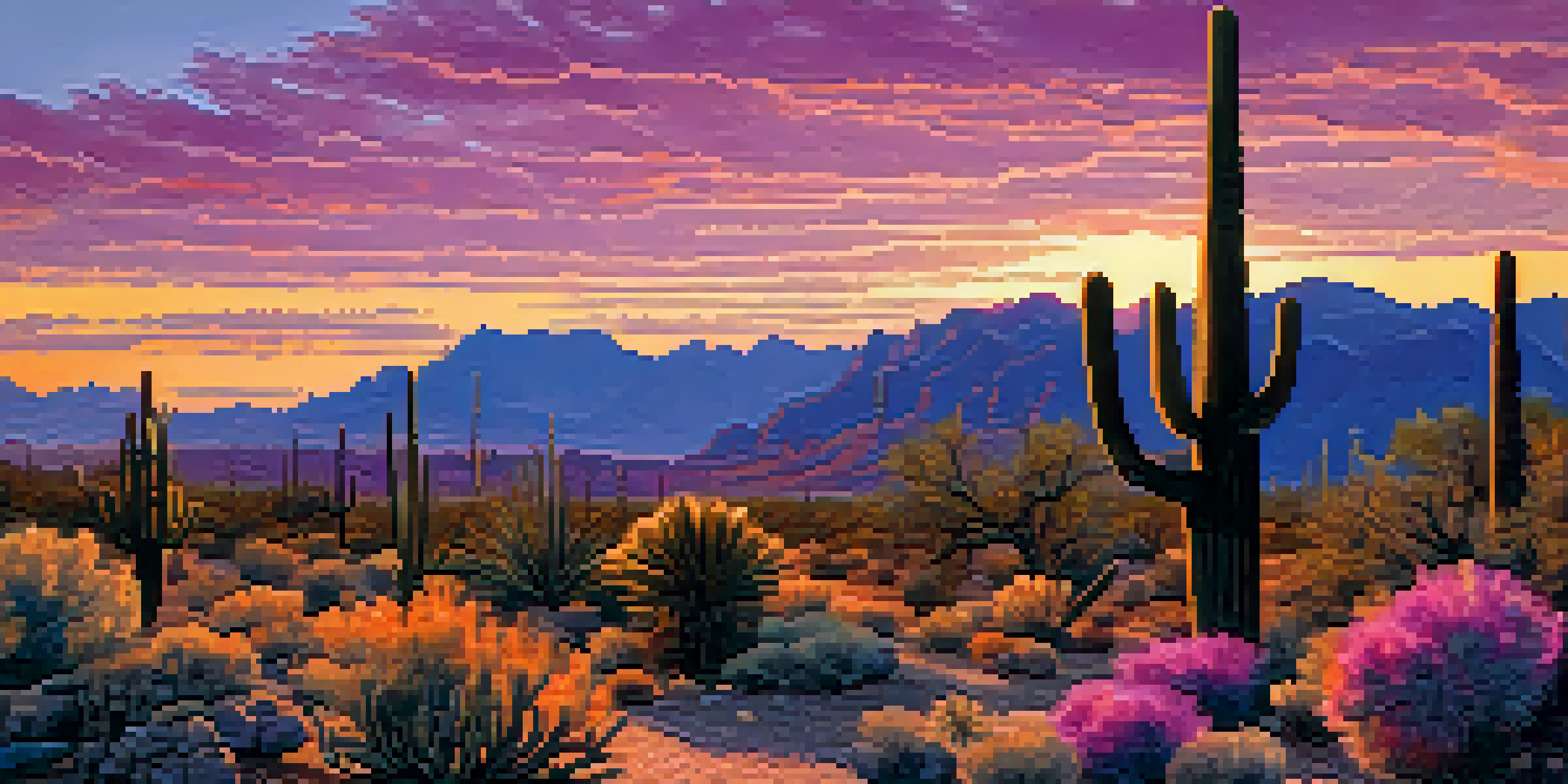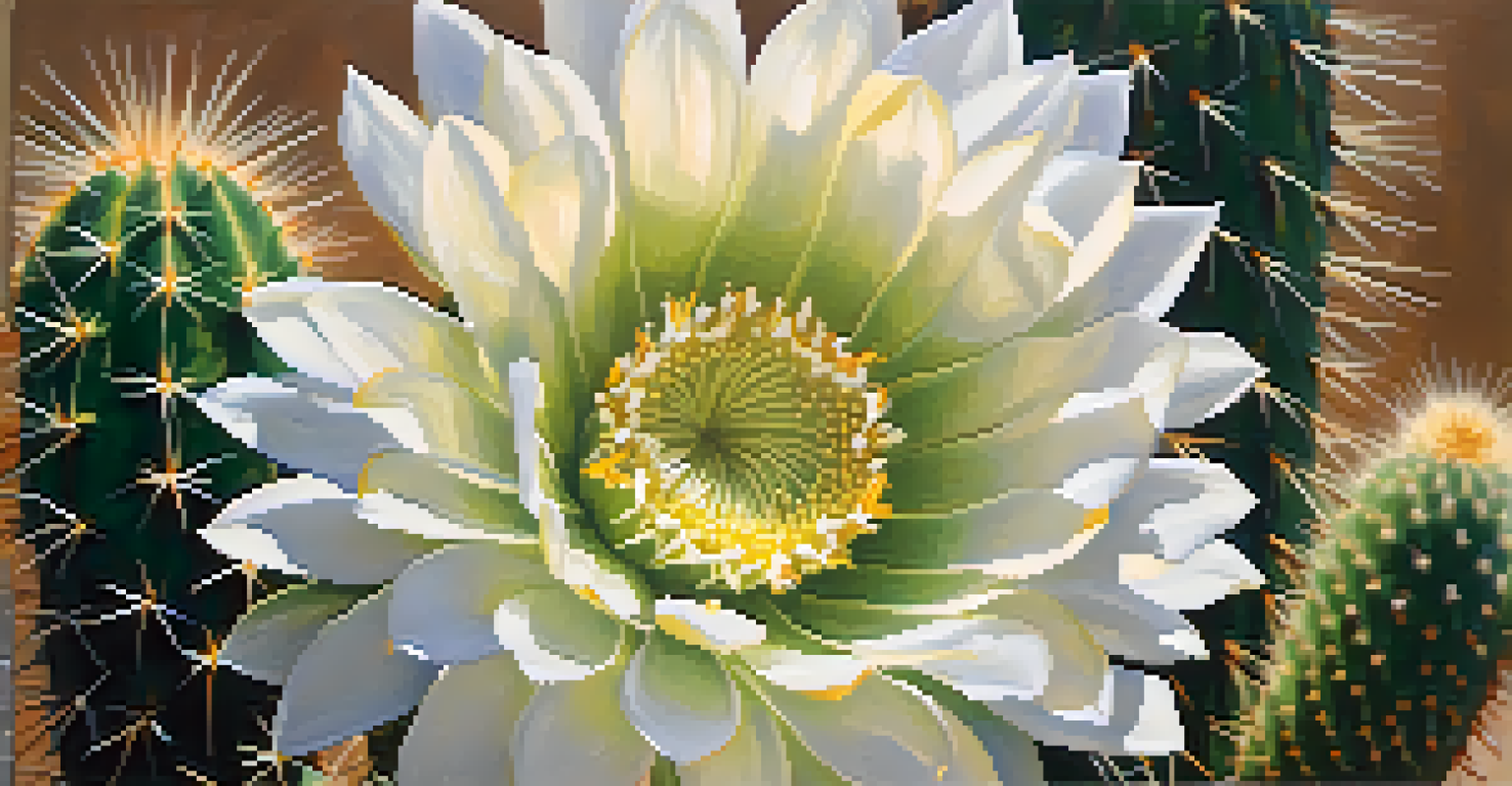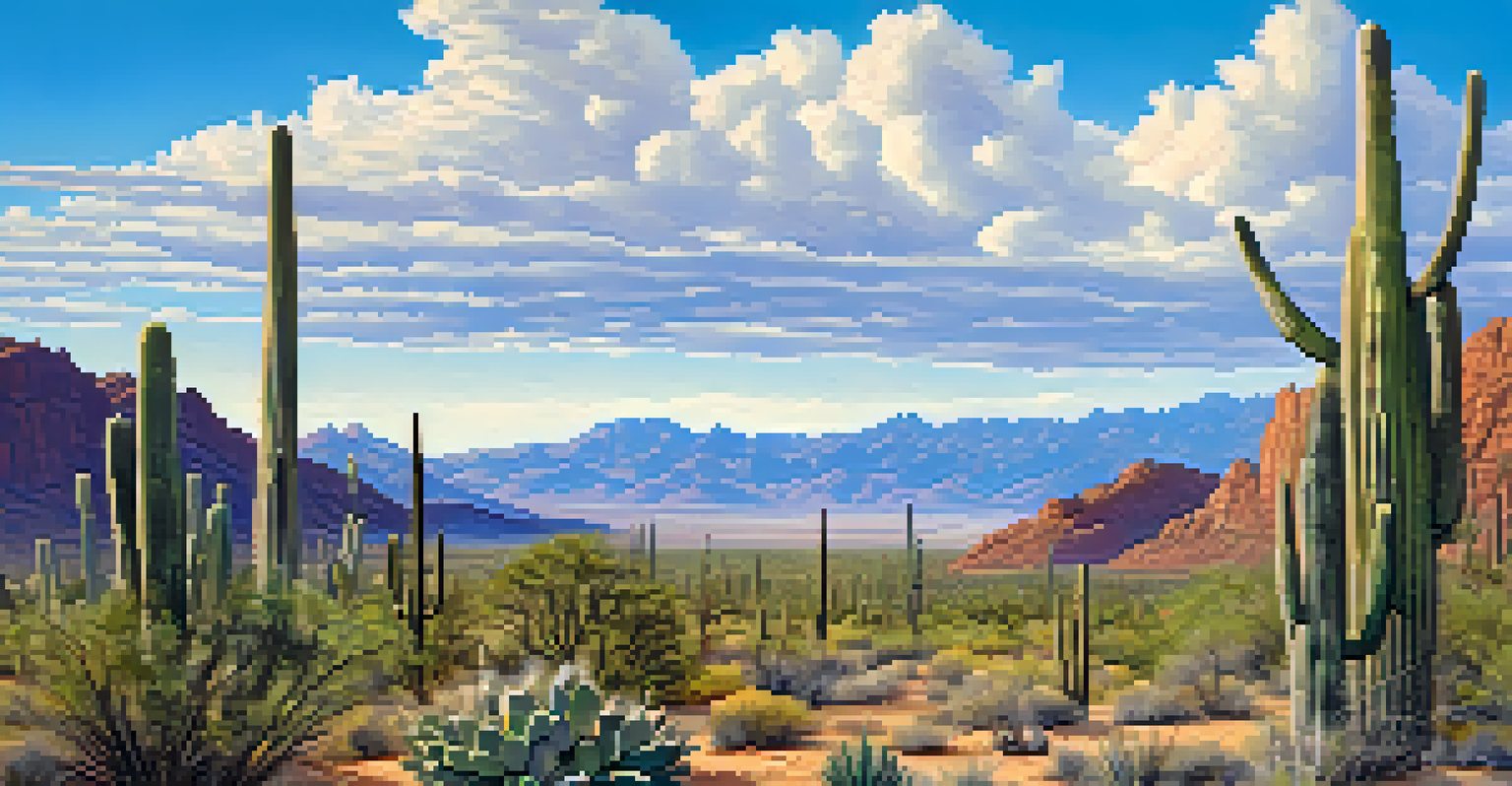Tucson's Iconic Saguaro: An Ecological and Cultural Icon

The Saguaro: A Symbol of the Sonoran Desert
The saguaro cactus is not just a plant; it's a symbol of the Sonoran Desert and the American Southwest. Towering up to 40 feet, these iconic cacti have become synonymous with the desert landscape, often depicted in art and literature. Their unique silhouette, especially when adorned with arms reaching skyward, captures the imagination and embodies the spirit of resilience.
The desert tells a different story every time one ventures into it.
Living for over 150 years, saguaros are remarkable for their size and longevity. They can weigh between 1,500 to 2,200 pounds when fully hydrated, showcasing their impressive ability to store water in a harsh environment. This impressive adaptation allows them to thrive in extreme conditions, illustrating the intricate balance of nature in the desert ecosystem.
The saguaro's significance extends beyond its physical presence; it plays a vital role in the local ecosystem. As a keystone species, it provides food and shelter for various animals, including birds, mammals, and insects. For instance, the Gila woodpecker and the purple martin rely on the saguaro for nesting, demonstrating how interconnected life is in the desert.
Cultural Significance of the Saguaro
The saguaro cactus holds deep cultural significance for Indigenous peoples of the Sonoran Desert. For the Tohono O'odham Nation, the saguaro is not just a plant; it's a vital resource, traditionally harvested for food and materials. The harvest of the saguaro fruit, which occurs in late June, is celebrated with community gatherings, highlighting its importance in cultural heritage and sustenance.

Beyond its practical uses, the saguaro has woven itself into the spiritual fabric of local cultures. Many Indigenous stories and legends feature the saguaro, symbolizing strength, endurance, and the connection to the land. These narratives help preserve the history and traditions of the communities who have lived in harmony with the desert for centuries.
Saguaros: Ecological Keystone Species
The saguaro cactus is a vital part of the Sonoran Desert ecosystem, providing food and shelter for numerous wildlife species.
In contemporary culture, the saguaro is featured prominently in art, photography, and tourism. Artists capture its beauty in paintings and sculptures, while visitors flock to see these majestic cacti in their natural habitat. This blend of tradition and modern appreciation ensures that the saguaro remains a beloved icon of the region.
Ecological Role of the Saguaro
Saguaros play a crucial ecological role in the Sonoran Desert ecosystem. As a keystone species, they provide essential habitat and food for an array of wildlife. Their blossoms, which bloom in late spring, offer nectar to pollinators like bats and bees, ensuring the continued health of the ecosystem and promoting biodiversity.
In every walk with nature one receives far more than he seeks.
The saguaro's fruit is a seasonal feast for various animals, including coyotes, javelinas, and birds. This not only supports local wildlife but also facilitates the dispersal of seeds, helping to propagate new saguaros. This cycle of life exemplifies the interconnectedness of species and the importance of preserving natural habitats.
Additionally, saguaros contribute to the desert's unique microclimate. By providing shade and shelter, they create cooler environments for other plants and animals to thrive. This ecological balance is vital for maintaining the health of the desert landscape, showcasing the importance of each species, no matter how large or small.
Threats to Saguaro Populations
Despite their iconic status, saguaros face several threats that jeopardize their populations. Urban development in Tucson and surrounding areas has led to habitat loss, pushing these majestic cacti into smaller, fragmented spaces. This not only affects the saguaros but also the diverse wildlife that depends on them for survival.
Climate change presents another significant challenge for saguaros. Rising temperatures and altered precipitation patterns can disrupt their growth and reproduction cycles. As water becomes scarcer, especially in drought-prone areas, the ability of saguaros to thrive diminishes, putting their long-term survival at risk.
Cultural Significance to Indigenous Peoples
For Indigenous communities, the saguaro cactus represents a crucial resource and is deeply woven into their cultural traditions and stories.
Additionally, illegal harvesting and vandalism threaten existing populations. Certain cultural practices, while respectful, can sometimes lead to overharvesting if not managed sustainably. Conservation efforts are essential to ensure that these iconic cacti continue to thrive for future generations.
Conservation Efforts for Saguaros
Recognizing the importance of saguaros, various conservation efforts have been implemented to protect these iconic plants. Organizations work to educate the public about the ecological and cultural significance of the saguaro, fostering a sense of stewardship among residents and visitors alike. Community workshops and educational programs aim to raise awareness about the need for conservation.
Protected areas, such as Saguaro National Park, play a critical role in preserving these cacti and their habitats. These parks not only safeguard the saguaros but also provide a space for research and monitoring of their populations. By creating designated areas for protection, we can ensure the survival of saguaros and the ecosystems they support.
Additionally, collaboration with Indigenous communities is vital for effective conservation. Their traditional knowledge and practices offer valuable insights into sustainable management of saguaros. By incorporating Indigenous perspectives, conservation initiatives can be more effective and respectful of cultural values.
The Saguaro in Popular Culture
The saguaro cactus has become a cultural icon, representing the spirit of the American Southwest in various forms of media. From classic Western films to contemporary photography, these towering cacti are often featured prominently, capturing the imagination of audiences worldwide. They symbolize not only the desert landscape but also the resilience of life in harsh conditions.
In art, saguaros inspire countless painters, sculptors, and photographers, who incorporate their unique forms and beauty into their work. Festivals and events celebrating the saguaro often feature local artists showcasing their interpretations, further embedding the cactus into the cultural identity of the region. This artistic representation helps to foster a deeper appreciation for the saguaro and its ecosystem.
Threats to Saguaro Populations
Urban development, climate change, and illegal harvesting pose significant threats to the survival of saguaros in their natural habitat.
Moreover, the saguaro has found its way into literature, where authors use its imagery to evoke themes of survival and perseverance. Stories set against the backdrop of the Sonoran Desert often highlight the saguaro as a symbol of hope and endurance, resonating with readers and adding to its cultural significance.
Experiencing the Saguaro Firsthand
For those looking to connect with these magnificent cacti, visiting Saguaro National Park is a must. The park offers numerous trails where visitors can experience the beauty of saguaros in their natural habitat. Walking among these giants provides a sense of scale and wonder that photographs simply cannot capture.
Guided tours and educational programs within the park offer insights into the ecology and culture surrounding the saguaro. Knowledgeable guides share stories about the cactus’s significance to Indigenous peoples and the ecosystem, enriching the experience for visitors. Engaging with the land in this way fosters a deeper appreciation for the saguaro and its environment.

In addition to national parks, local communities often host events celebrating the saguaro and its importance. From harvest festivals to art shows, these gatherings create opportunities for people to learn about and honor the saguaro. They remind us that the saguaro is not just a plant but a cherished part of the cultural and ecological landscape of Tucson.